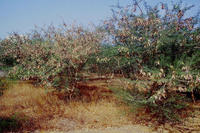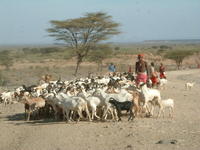Project INCO - ACACIAGUM - Innovative Management of Acacia senegal Trees to Improve Land Productivity and Gum Arabic Production in Arid and Semi-Arid Sub-Saharan Africa
Project
More than one half of Africa’s land surface (55%) is dryland (dry sub-humid, semi-arid and arid).Drylands are generally characterized by harsh environmental conditions resulting from scant (100-600mm) and erratic rainfall with poor reliability and prone to drought, a high evaporative demand and poor (or poorly) developed soils. Grasses and bushes/shrubs are among the principal natural resources supported by the above climatic and edaphic conditions.
Africa’s dryland are home to about 235 million people. Pastoralism (nomadic in the more arid areas) and agro-pastoralism are the main economic mainstays of the rural population. Against expectations, drylands in Sub-Saharan Africa are experiencing high population growth, which is one of the major causes of land degradation.

There is urgent need to mitigate land degradation and hence desertification in Africa’s drylands.One way is to diversify the economic base by recognizing and developing the potential inherent in the plant resources found in these areas.Among the plant resources is Acacia senegal , a highly valued multi-purpose tree species known for its ability to grow in areas with rainfall as low as 200mm, able to restore soil fertility in degraded areas through symbiotic association with some micro-organisms and is a source of internationally sought after gum Arabic.

Recognizing the above potential and desire to sustainability manage the environment and improve livelihoods of communities living in the drylands of Sub-Saharan Africa, the European union is supporting European and African scientists in equal partnership to combine their expertise to improve resources productivity and gum Arabic production through an INCO-DEVproject code named ACACIAGUM.The overall objective of ACACIAGUM is to combine high gum quality with increased gum production and sustainable tree management for improved rural livelihoods.
© CIRAD - 2008 - All rights reserved